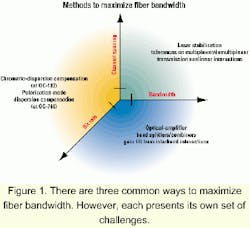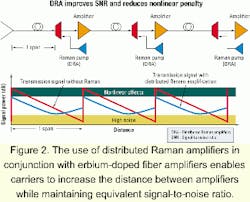Opening the S-band, and more, with Raman amplification
Extending transmission distances is not the only benefit of Raman amplification, thanks to new, high-power pump lasers.
SHARLENE LIN, Xtera Communications
Driven by recent technological advances, DWDM is the fastest and most cost-effective way to maximize and extend bandwidth capacity. Current DWDM methods to maximize bandwidth per fiber include increasing channel bit rates to 10 Gbits/sec and 40 Gbits/sec and decreasing channel spacing from 100 GHz down to 25 GHz (Figure 1). Chromatic-dispersion issues, polarization-mode-dispersion (PMD) compensation, and high-speed ASIC development issues will delay broad 40-Gbit/sec transmission deployment to beyond 2001. Laser stabilization and fiber nonlinearity issues must be solved before finer channel spacing can be implemented. In time, both methods of increasing fiber capacity will be incorporated into DWDM systems to achieve capacities needed in carrier networks.
A third, more easily achievable method of increasing bandwidth per fiber is to open additional bands within the fiber. The industry has widely deployed DWDM in the C-band (conventional band). The L-band (long-wavelength band) has been viewed as the obvious expansion band, as the amplification method using erbium-doped fiber amplifiers (EDFAs) can be extended from the C-band.
Another band, the S-band (short-wavelength band), has been generally overlooked, as EDFAs are unusable in the shorter-wavelength bands, since erbium ions do not emit light below 1,525 nm. With breakthroughs in Raman amplification, the S-band is now proving to be a significant contender in bandwidth expansion.
Already, Raman amplification technology has found its way into ultra-long-haul networks to allow greater distances to be achieved without electrical regeneration. Using distributed Raman amplifiers (DRAs), traditional signals are launched into the fiber span with power levels below the level at which the fiber nonlinearity penalties become significant. At the same time, the fiber is reverse pumped to induce a Raman gain that results in achieving an equivalent signal-to-noise ratio (SNR) at a longer span distance (Figure 2). Distributed Raman amplification makes use of the transmission-line fiber as the gain medium.
In a network built without DRAs, a DWDM signal can traverse approximately six 80-km spans without regeneration, roughly 500 km. Using 500- to 600-mW pumps to power distributed Raman amplifiers at each tailend site, a lower-power signal can be transmitted at the headend, resulting in an SNR improvement of approximately 6-7 dB in each span. The cumulative SNR improvement results in a fully populated DWDM signal that can now traverse up to 12 spans, or 1,000 km, without costly electrical regeneration.Even greater span counts can be achieved using DRAs, if there is only a partial fill of channels within the DWDM signal. Additional distances can also be accomplished by reducing amplifier span spacings to, say, 50 km. Achieving greater distances without electrical regeneration represents huge savings for carriers-so much so that, according to a recent CIBC World Markets study, the Raman market, based on distributed Raman applications alone, is projected to grow from $220 million in 2000 to $4.5 billion in 2005 (see "Raman Amplification: Longer, Wider, Faster, Cheaper," CIBC World Markets, Nov. 28, 2000).
Although Raman amplification has been well understood for many decades, high-power pumps were uncommon and thus expensive. Fueled by DRA applications, component manufacturers have now engineered economical high-power pump lasers that support the commercial viability of this amplification technique.
Pump power efficiencies have improved 100-fold, with new power laser diodes supplying greater than 1 W of output power to the fiber. New diode-array-cladding pumped lasers are reaching output power levels of 10 W and above. Manufacturers can now produce lasers at a wider range of wavelengths, as well.
Improvements in fiber and fiber packaging techniques have also propelled Raman applications. Fibers used as the gain medium are now manufactured with smaller diameters, reducing fiber spool sizes. Also, today's commercial fibers have lower loss, reducing the quantity of gain medium required for amplification.
All of these recent technological breakthroughs have opened Raman-based applications beyond just DRAs. With volume production of Raman-friendly devices, the economics of using Raman is now on par with, if not better than, EDFA technology, but the advantages of Raman have not been fully explored and exploited, making Raman a technology that's ripe for innovation.
Raman amplification technology, when applied in a discrete rather than distributed application, opens up an alternative to EDFA technology as the means for amplifying broad wavelength regions in fiber. Discrete Raman amplifiers, sometimes referred to as "lumped Raman amplifiers," incorporate the gain medium into the amplifier itself, rather than relying on the transmission-line fiber. All of the pump power is confined to this medium, allowing full optimization of the amplifier.
Unlike EDFAs, Raman gain is not limited to any specific wavelength region. Over time, applications may extend over the entire transparent band, from 300 nm up to 2,000 nm and even into the visible band. For near-term DWDM applications, Raman gain can realistically be applied in the 1,300- to 1,700-nm low-loss region of fiber. An EDFA's useful range is between 1,525 and 1,620 nm, a small, approximately 100-nm window.Discrete Raman amplifiers exploit the nonlinear effects of stimulated Raman scattering (SRS) to strategically direct energy transfers between channels in an optical wave. A direct increase in power at one wavelength will cause exponential increases in gain on a range of wavelengths that are near 13.2 THz (or ~100 nm, at 1,550 nm-see Figure 3) greater than the pumped wavelength. For example, by pumping near 1,460 nm, the wavelength region between 1,530 and 1,570 nm becomes optimally amplified. Gain spectrum can be widened and tailored by using multiple pump lines and using pump distribution to achieve gain flatness.
Carriers with fiber-constrained networks need more bandwidth on existing fibers to enable new revenue-generating opportunities. These carriers already operate with traditional C-band systems and must look for additional ways of expanding capacity. Expansion into the L- and S-bands offers near-term relief, allowing a tripling of capacity.
Capacity upgrades enabled by supplementing with S-band and L-band channels can be introduced under the network-management system of the network operator's existing C-band equipment, so the network operator doesn't see any difference in the equipment in terms of operations. However, a carrier must prepare its network for expansion by adding an optical coupler when installing the standard C-band DWDM system. Otherwise, a disruption in service will take place when the coupler is installed.
Distributed Raman can be layered on all bands to achieve greater span distances. All bands that carry 10 Gbits/sec today have the potential to be fitted with 40 or 80 Gbits/sec in coming years. As finer channel spacings are engineered for any given transmission rate, all bands will have the potential to support these spacings.
Expansion into the S-band on a C-band system can occur with or without prior expansion into the L-band. In fact, channel expansion into the S-band may prove easier than expanding into the L-band.
Many DWDM systems were built with the intention of operating in the C-band only. As such, little or no headroom was designed into the C-band EDFA gain. Due to the same SRS effect that enables Raman amplification, the L-band amplifier, built with either EDFA or discrete Raman, robs power from the C-band. If the C-band is depleted of more power than the C-band EDFAs can supply, affected C-band channels will cease to function.
This condition does not occur with the addition of S-band channels. Since S-band signals are of shorter wavelengths, the S-band amplifier actually pumps the C-band, reducing required C-band EDFA gain.
Carriers that are not fiber constrained can benefit not only from augmenting C-band systems but also from deploying new systems designed to be multiband from the onset. The robbing of power between the bands is considered in the overall design, and system growth can be more easily staged.A multiband system could comprise EDFA-only elements, mixed EDFA/ Raman elements, or Raman-only elements. An EDFA-only multiband amplifier can support only a narrow 100-nm wavelength range. Growth in available bandwidth will depend on progress in finer channel spacings and higher bit rates. A mixed EDFA/Raman system will offer more bandwidth than an EDFA-only system. The two technologies have already demonstrated compatibility when combined to achieve greater span distances. Even if a first-generation Raman-based multiband amplifier today encompasses only the S-, C-, and L-band regions, the channel capacity extends beyond just 96 channels x 3 bands. Delineation between bands is no longer necessary. Guard-bands of 7-10 nm between each band that were unusable previously are now free to carry channels, further increasing fiber capacity.
As pump lasers are created for broader ranges of wavelengths, usable capacity on fibers will continue to grow with Raman technology, not stopping at a mere doubling or quadrupling of capacity. As more wavelengths are used, discrete Raman technology becomes even more efficient. Cascading of pumps conserves total power and reduces the number of pumps required. Further, all pumps can share the same gain medium, resulting in cost as well as space savings. As an abundance of channels becomes available on a fiber, carriers may someday have the luxury of transporting larger and larger portions of their wavelength services without the burden of multiplexing to higher bit rates, a costly addition to any network.
When both distributed and discrete Raman amplification are implemented to augment C-band systems, the resulting product becomes supercharged. Not only does the number of channels double with the addition of the S-band, but also the span distances, without electrical regeneration, doubles as well. The improved distances apply to both the C- and S-bands.
Improved performance and capacity at lower network costs add new life and revenue opportunities for both the DWDM equipment supplier and the carrier. Adding channels in the S-band can significantly reduce the overall cost of network expansion versus lighting new fiber. Even carriers with an abundance of fiber must consider the opportunity costs in lighting a fiber verses leasing that fiber for revenue. An augmentation strategy provides a method for carriers to get more revenue-bearing capacity out of existing fiber and equipment without having to put in yet another network element at every terminal or in-line site. Carriers can more quickly turn up billable service when they are simply adding more channels to existing equipment on fiber that has already been tested using a workforce already trained on the equipment.
Since earnings performance always matters, carriers must carefully select the most efficient means of quickly growing their network, while watching capital expenditures and weighing the impact of the selected technology on network operating costs. Extending the useful life of capital assets, the fiber and the equipment to bring in new revenue-generating services are certainly a no-risk decision for a carrier and a practical strategy for the incumbent equipment provider.
Sharlene Lin is director of marketing at Xtera Communications (Allen, TX).



